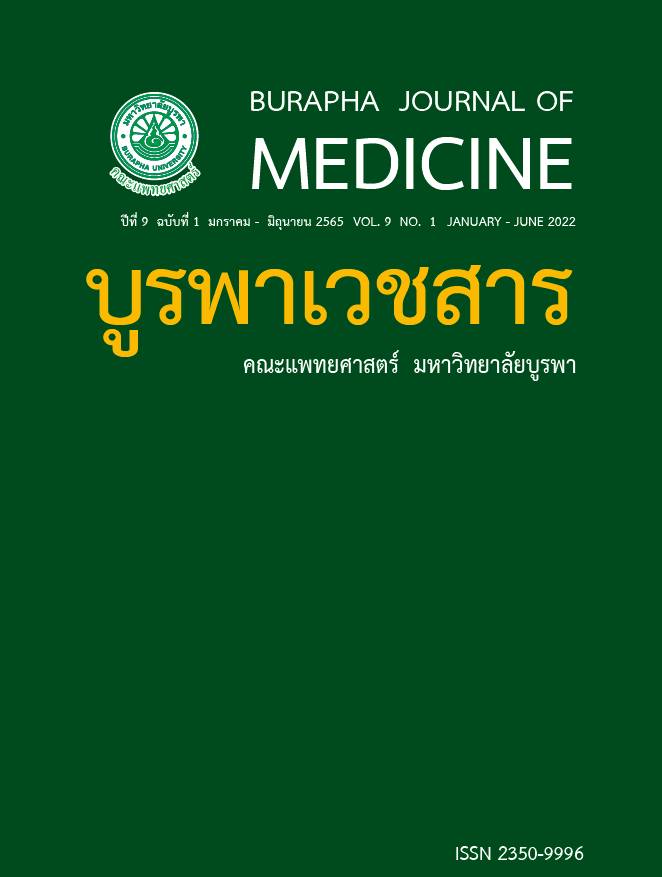ปัจจัยทำนายคุณภาพชีวิต ของบุคลากรทางการศึกษาภาครัฐในเขตภาคตะวันออก
คำสำคัญ:
คำสำคัญ: จิตใจ, อารมณ์, จิตวิญญาณ, คุณภาพชีวิต, บุคลากรทางการศึกษาบทคัดย่อ
Context: A person’s full potential productivity has a correspondence with his or her quality of life. Therefore, in the public education sphere, determining the quality of life of government education personnel includes mental, emotional and spiritual factors. Focusing solely on the
eastern region of Thailand, it will help first to understand the living situations of public educators in this territory, in order to make predictions or create activities to encourage the workforce to have a better quality of life.
Objective: To study the mental, emotional and spiritual factors affecting the quality of life of government educators in the eastern region of the country.
Materials and Methods: In this exploratory research project, a sample of 388 teachers and public school administrators from the eastern regions of Chonburi, Chachoengsao, Chanthaburi and Rayong provinces was selected. The sample size was determined using Krejcie and Morgan tables9 with multistage randomization. The research instruments were the Thai happiness index, a general health questionnaire, a spiritual well-being questionnaire and the World Health Organization’s quality of life assessment (abbreviated Thai version). Descriptive statistics and multiple regression were used for data analysis.
Results: The results revealed that most of the samples were female (70.6%), with an average age of 38 years. 57.7% of the participants had attained a bachelor’s degree, were working an average of 12.09 years, and had an average teaching load of 17.81 hours per week. 74.20% had
no congenital diseases. 92.8% of the participants were non-smokers, and 81.44% did not drink alcohol. 35.86% exercised once a month – 58% of those by walking. 46.9% of the participants exercised between 4.00 p.m. and 6.00 p.m., (with 28.35% wanting to change their exercise behavior. From our sample, the overall quality of life was within the criteria of a good quality of life. The average happiness score was at the same level as a general person in other work industries. The participants were in general health, with no mental health problems and a high spiritual well-being. Factors related to their quality of life were found as follows:
(1) The Thai happiness index variable and the work duration variable significantly predicted the quality of life variables at the .01 level. The predicted equation was as follows: quality of life = 43.779 + (1.632 x Thai happiness index variable) + (0.154 x duration of being a teacher).
(2) Married participants had a 2.03 times better quality of life than single, widowed, divorced and separated personnel, with a statistical significance (p < .01).
(3) The relationship between income and quality of life factors found that those with residual income, either from earned income or for emergency use, were associated with a good quality of life. It was 7.68 times and 4.30 times higher, respectively, compared to those with insufficient incomes, with a statistical significance (p < .01).
(4) The correlation between congenital disease and quality of life found that the group with no underlying diseases was 2.63 times more associated with a good quality of life, than the group with congenital diseases, at a statistical significance at the .01 level.
Conclusion: Although the overall public educator had happiness, spiritual well-being and quality of life at good levels, they would still like to adjust, i.e. increase, their exercise behavior. Additionally, work duration correlated to their quality of life. The married status group too was associated with a better quality of life than the single, widowed, divorced or separated participants. Likewise, the surplus income and emergency residual income groups were both related to good qualities of life. The people without any underlying diseases correlated to
a good quality of life more than the group with congenital diseases. Therefore, educational institution administrators should establish policies that allow personnel to have the chance to perform health activities as needed, and create activities to enhance the quality of life to improve society, environment and health.
เอกสารอ้างอิง
World Health Organization. Quality of Life assessment (WHOQOL): position paper from the World Health Organization. Soc Sci Med 1995; 41: 1403-9. doi:10.1016/0277-9536(95)00112-k.
ชื่นฤทัย กาญจนะจิตรา. สุขภาพคนไทย 2551. นครปฐม: สถาบันวิจัยประชากรและสังคม มหาวิทยาลัยมหิดล; 2551.
วิพุธ พูลเจริญ. สุขภาพ: อุดมการณ์และยุทธศาสตร์ทางสังคม. พิมพ์ครั้งที่ 1. กรุงเทพฯ: สถาบันวิจัยระบบสาธารณสุข; 2554.
ประเวศ วะสี. สุขภาวะทางปัญญา. มติชน. 2551 สืบค้นเมื่อ 27 กุมภาพันธ์ 2552, จาก http://library.uru.ac.th/webdb/mages/prawase.com-article-149.pdf
ดิเรก พรสีมา และธัญสินี เล่าสัม. วิจัยอย่างไรจึงจะถูกต้อง สมบูรณ์ สร้างสรรค์ และเป็นประโยชน์. คุรุสภาวิทยาจารย์. 2563; 1: 1-14.
จุรีพร แจ้งธรรมมา. คุณภาพชีวิตการทำงานของครูระดับมัธยมศึกษาสังกัดกรมสามัญศึกษาเขตพื้นที่การศึกษา 5. วิทยานิพนธ์, ศศ.ม., มหาวิทยาลัยมหิดลกรุงเทพฯ; 2545.
พรศิริ เทียนอุดม. ปัจจัยส่งเสริมคุณภาพชีวิตการทำงานของครูต้นแบบ. วิทยานิพนธ์, ค.ม., กรุงเทพฯ: สถาบันราชภัฏจันทรเกษม; 2546.
อารี สังข์ศิลป์ชัย. คุณภาพชีวิตการทำงานของครูผู้สอนในโรงเรียนสังกัดสำนักงานเขตพื้นที่การศึกษานครปฐม. วิทยานิพนธ์ ค.ม., มหาวิทยาลัยราชภัฏนครปฐม, นครปฐม; 2548.
Koenig, H. G. Religion, spirituality, and health: The research and clinical implications. ISRN Psychiatry. 2012 Retrieved from http://www.hindawi.com/journals/isrn/2012/278730/abs/
สุวัฒน์ มหันตนิรันดร์กุล, วิระวรรณ ตันติพิวัฒนสกุล, วนิดา พุ่มไพศาล. เปรียบเทียบแบบวัดคุณภาพชีวิตขององค์การอนามัยโลกทุก 100 ตัวชี้วัด และ 26 ตัวชี้วัด. โรงพยาบาลสวนปรุง จังหวัดเชียงใหม่; 2540
อภิชัย มงคล, วัชนี หัตถพนม, ภัสรา เชษฐ์โชติศักดิ์, วรรณประภา ชลอกุล, ละเอียด ปัญโญใหญ่, สุจริต สุวรรณชีพ. การศึกษาดัชนีชี้วัดสุขภาพจิตคนไทย(ระดับบุคคล). วารสารสมาคมจิตแพทย์แห่งประเทศไทย 2554; 46: 209-25.
Goldberg DP. The detection of psychiatric illness by questionaire. Maudsley Monograph No 21. London: Oxford University Press; 1972.
ธนา นิลชัยโกวิทย์, จักรกฤษณ์ สุขยิ่ง, ชัชวาล ศิลปะกิจ. ความเชื่อถือได้และแม่นตรงของ General Health Questionnaire ฉบับภาษาไทย.วารสารสมาคมจิตแพทย์แห่งประเทศไทย. 2539; 41: 2-17.
กนิษฐา ลิ้มทรัพย์. การตระหนักรู้ในตนเอง การมองโลกในแง่ดี ความพึงพอใจในชีวิตและความผาสุกทางจิตวิญญาณของผู้สูงอายุในศูนย์บริการผู้สูงอายุดินแดง เขตดินแดง กรุงเทพมหานคร. ปริญญานิพนธ์ วท.ม. (จิตวิทยาชุมชน). กรุงเทพฯ:บัณฑิตวิทยาลัย มหาวิทยาลัยเกษตรศาสตร์; 2557.
กำชัย เสนากิจ. คุณภาพชีวิตการทำงานของครู สังกัดสำนักงานเขตพื้นที่การศึกษามัธยมศึกษาเขต 26. วารสารวิชาการศรีปทุม ชลบุรี. 2561; 15: 245-52.
ทนงศักดิ์ ยิ่งรัตนสุข, กาญจนา พิบูลย์, ธนิดา จุลวนิชย์พงษ์, พวงทอง อินใจ. ลักษณะงานและปัจจัยที่มีความสัมพันธ์กับความเครียดจากการทำงานของครูในโรงเรียนมัธยมศึกษา จังหวัดชลบุรี. บูรพาเวชสาร 2563; 7: 32–46.
Edlin G, Golanty E, Brown K Mc C. Essentials for health and wellness. 2 nded. Sudbury: Uones and Bartlett; 2000.
ธนภร จันทร์สี, สุชาติ บางวิเศษ, จำนง ศรีมังกร. Proceeding of the National and international Graduate Research Conference 2016, Graduate School, KhonKaen University, Thailand and Universitas Muhammadiyah Yogyakarta, Indonesia; 2559: 1236-43.
คณะครุศาสตร์ มหาวิทยาลัยราชภัฏสุราษฎร์ธานี. เอกสารประกอบการสอนรายวิชาความเป็นครูและคุณธรรมจริยธรรม. [อินเตอร์เน็ต]. 2562 [เข้าถึงเมื่อ 5 ธ.ค. 2561]. เข้าถึงได้จากhttp://graduate.sru.ac.th/wp-content/uploads/2019/06/EDU0101_Teacher-and-moral-ethics.pdf.
วิชัย จุลวนิชย์พงษ์, สุรีย์ เต็มศิริพันธุ์, วรรณา บัวสุวรรณ, เมธาพร ภูมิรุ่งเรือง, จริยา อภิชาติวณิชย์, น้ำฝน วรรัตน์, ศธัญญา บัวสุวรรณ. ปัจจัยที่มีความสัมพันธ์ต่อภาวะเบาหวานจากการคัดกรองในกลุ่มประชากรอายุตั้งแต่ 40 ปีขึ้นไปของตำบลอ่างศิลา อำเภอเมือง จังหวัดชลบุรี. วารสารสำนักงานป้องกันควบคุมโรคที่ 3 จ.ชลบุรี. 2551; 1: 191-5.
วิชัย จุลวนิชย์พงษ์, รัชณี ธาราสันติสุข, จงรักษ์ หวังเชื้อ, บุษบา ใจกล้า, จันทนา บุญส่ง, สุภาวัลย์ จาริยะศิลป์, ยุพดี ชมดี, เอื้อมพร รักจรรยาบรรณ. ประสิทธิผลของการออกกำลังกายและออกแรงกายแบบแอโรบิกในการป้องกันภาวะเบาหวานจากการคัดกรองในกลุ่มประชากรที่มีระดับน้ำตาลในเลือด 110-125 มิลลิกรัมต่อเดซิลิตร. วารสารสำนักงานป้องกันควบคุมโรคที่ 3 จ.ชลบุรี. 2552; 2: 104-16.



